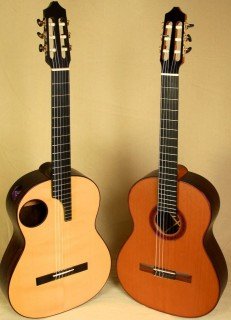Duane Waterman makes the best desert guitars
In 1973 I went searching for a guitar maker to make a special acoustic instrument for me. Instead, I was introduced to - and then became obsessed with - the art/craft/science of guitar making. The more I learned about guitar making the more I was drawn to it. Not long after this introduction, I decided to pursue musical instrument making as my vocation. On the recommendation of one of the guitar makers that I met at that time I also began to repair guitars to augment and accelerate my learning and experience. I started my career in guitar building and repair in the Midwest. For several years I made American folk instruments - steel string guitars, mandolins and dulcimers. By 1979, after relocating to Colorado, my interest in nylon string classical guitars began with making a few of these guitars yearly for students in a local university guitar program. I continued to make finger-style steel string guitars while also pursuing the goal of developing my classical guitars into true concert level instruments.
The musical demands are similar
To me, classical guitars are the Formula 1 of guitar types. The preferred compositions - historic and current, the technical discipline needed for acceptable performance, and the concert instruments themselves are highly refined. There are guitar makers that focus tightly on re-creating exact models of instruments from earlier periods - similar to the work of violin makers - but many others today are working to evolve the instrument with new materials, forms of construction and more modern features - like elevated fingerboards and side sound ports.
The concert guitar is certainly not a "finished" item.Like many of my contemporaries in the 20th century, I began by making instruments that adhered closely to Torres - and Hauser l - with spruce tops and 7 symmetrical fan braces. After finishing about 50 of these instruments over 6 years I started making slightly larger, cedar models influenced by the Jose Ramirez and Miguel Rodriguez concert models. These were more successful guitars for me - appealing to a broader range of players. In the last 20 years or so the revolutionary work of Greg Smallman (lattice style construction), Mattias Dammann (Double tops), and Schneider/Kasha (Radial bracing and a modern aesthetic) has influenced my building to varying degrees, as it has with many other makers around the world.
Currently, I make two general models: One, I call the Concert Classical. These are distinguishable by a center sound hole, like all traditional guitars. These are designed in a variety of cosmetic motifs - from mosaic rosettes with simple, yet elegant black/white trims to more elaborate, modern rosettes with distinctive colors that also match the body edge trims. Several are illustrated on my website (sonoraguitars.com) with more photos and video/
Renato Serrano plays Agustin Barrios - Choro de Saudade
A fantastic interpretation of Choro de Saudade, a piece
Find this guitar via sonoraguitars.com
When you subscribe to the blog, we will send you an e-mail when there are new updates on the site so you wouldn't miss them.




